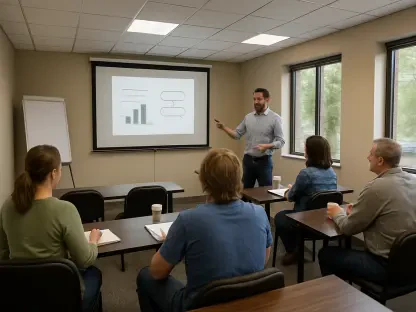In the realm of higher education, few debates have sparked as much contention as the recent scrutiny faced by New College of Florida, where President Richard Corcoran has found himself at the center of a storm over financial efficiency. Critics, armed with a Department of Education report—commonly referred to as the DOGE report—have painted the institution as fiscally irresponsible, citing a staggering cost-per-student figure that towers over other state universities in Florida. Yet, Corcoran has fired back with a compelling rebuttal, asserting that such criticism stems from a fundamental misreading of the data, devoid of the context surrounding the college’s unique challenges and remarkable turnaround. This clash over numbers and narratives raises broader questions about how educational value is measured, particularly for smaller institutions with distinct missions. As the debate unfolds, it becomes clear that the story of New College is far more complex than a single metric can convey, inviting a deeper look into the realities behind the headlines.
Examining the Criticism
Dissecting the DOGE Report
The DOGE report has emerged as a flashpoint in the critique of New College, with its headline figure of $83,207 as the cost-per-student drawing sharp accusations of financial mismanagement compared to other Florida state universities. This statistic, presented without deeper analysis, suggests an institution out of step with fiscal norms, fueling narratives of inefficiency. However, a closer examination reveals that this number includes substantial one-time expenses unrelated to ongoing operations. When these are factored out, the adjusted cost drops to $58,784, aligning New College more closely with affordable liberal arts colleges nationwide. This discrepancy highlights a critical flaw in relying solely on raw data for judgment, as it obscures the nuanced financial picture of an institution in transition. The report’s narrow focus risks overshadowing the broader efforts to revitalize a campus long plagued by systemic issues, setting the stage for a debate that demands more than surface-level scrutiny.
Critics leveraging the DOGE report often emphasize cost metrics as definitive proof of poor stewardship, yet they frequently overlook the structural and historical factors that inflate these numbers for New College. This selective use of data, often amplified for dramatic effect in public discourse, ignores the reality of mandatory residential requirements and past neglect that larger state universities do not face to the same degree. Such cherry-picking creates a distorted image, prioritizing sensationalism over a balanced understanding of the institution’s circumstances. By focusing on a single, unadjusted figure, detractors sidestep the progress made in recent years, including enrollment growth and infrastructure renewal. This approach not only misrepresents the college’s current state but also undermines the potential for constructive dialogue about how to evaluate educational institutions with unique missions and constraints, pointing to a need for more comprehensive assessment tools.
Contextual Oversight
A significant critique of the DOGE report’s application lies in its failure to account for the historical context that has shaped New College’s financial landscape, particularly the decades of deferred maintenance that preceded the current leadership. Critics wield the report’s findings as a blunt instrument, often ignoring how past underinvestment in infrastructure—resulting in issues like black mold and unusable dormitories—has necessitated massive, one-time expenditures. These costs, totaling nearly $80 million, are not indicative of reckless spending but of a desperate need to restore a campus to functional standards. Without acknowledging this backdrop, assessments of the college’s efficiency appear unfairly skewed, painting a picture that disregards the inherited burdens that current administrators are working to overcome. This omission in critical discourse risks perpetuating a narrative that is more about scoring points than seeking truth.
Beyond historical neglect, the DOGE report’s critics often fail to consider the legal mandates that distinguish New College from its peers in Florida’s State University System, such as the requirement to operate as a residential liberal arts college with most students living on campus. This structural reality drives up expenses for housing and related services, a factor not comparably present at larger institutions where far fewer students reside on-site. By glossing over such distinctions, detractors create comparisons that are inherently unbalanced, equating New College’s operational model to those of vastly different universities without adjusting for context. This oversight not only muddies the waters of fair evaluation but also diminishes the validity of critiques that could otherwise contribute to meaningful reform. A more nuanced approach, one that weighs these unique constraints, is essential to understanding the true financial story of the institution.
Structural Challenges
Historical Neglect and Repairs
New College’s financial challenges are deeply rooted in a history of neglect that left the campus in disrepair long before the current administration took the helm, with nearly $80 million in deferred maintenance casting a long shadow over budget sheets. Crumbling dormitories, failing HVAC systems, and pervasive issues like black mold were not mere inconveniences but critical barriers to providing a safe learning environment. Addressing these problems has required significant funding, classified as non-recurring expenses, which have inflated the reported cost-per-student figure that critics so readily highlight. This investment, while substantial, is a necessary step to bring the college back from the brink of collapse, reflecting a commitment to future stability rather than fiscal extravagance. Ignoring this context distorts the narrative, framing essential repairs as evidence of mismanagement when they are, in fact, a response to decades of underfunding.
When these one-time repair costs are excluded from financial assessments, the cost-per-student at New College drops dramatically from $83,207 to $58,784, a figure that positions the institution among some of the more cost-effective liberal arts colleges in the nation. This adjustment challenges the prevailing critique of fiscal irresponsibility, revealing how much of the perceived inefficiency is tied to historical burdens rather than current operational choices. It underscores the importance of distinguishing between temporary expenditures and recurring budgets when evaluating an institution’s financial health. Far from being a sign of waste, the recent influx of funds directed toward infrastructure represents a strategic effort to rebuild a foundation for long-term success. This recalibrated perspective invites a rethinking of how financial data is interpreted, urging stakeholders to look beyond initial numbers to the underlying reasons for spending spikes in a college’s recovery phase.
Residential Mandate
New College operates under a legal mandate from the state of Florida to function as a residential liberal arts college, a requirement that sets it apart from many counterparts in the State University System and significantly impacts its cost structure. With nearly 80% of students living on campus—compared to just 25% at the University of Florida or 12% at the University of Central Florida—the expenses for housing, dining, and related services are inherently higher. This structural reality, embedded in state law, means that the college must maintain extensive residential facilities regardless of enrollment fluctuations, a burden not equally shared by larger institutions with more commuter students. Critics who fail to account for this mandate when comparing costs create a skewed picture, attributing higher per-student expenses to inefficiency rather than recognizing the policy-driven nature of these expenditures.
Direct comparisons between New College and larger state universities often miss the mark due to the fundamental differences in operational models, particularly regarding residential requirements that inflate costs in ways not applicable to schools with lower on-campus populations. This mismatch in assessment criteria results in unfair judgments that do not reflect the college’s unique obligations or the value it provides through a close-knit, residential learning environment. Research has shown that such settings can enhance student outcomes, especially in fostering engagement and retention after COVID-19, yet these benefits are rarely factored into cost critiques. By equating the financial profiles of institutions with vastly different missions and legal constraints, detractors risk undermining the distinct role that smaller, residential colleges play in higher education. A fairer evaluation would adjust for these inherent disparities, offering a clearer view of where true efficiencies or challenges lie.
Vision for the Future
Growth and Efficiency
Under the current leadership, New College has seen a remarkable surge in enrollment, climbing from just over 600 students to more than 900 in a short span, with an ambitious target of 1,200 by 2028. This rapid growth is central to the strategy for financial sustainability, as increasing student numbers can spread fixed costs over a larger base, ultimately reducing the per-student expense. Projections suggest a potential 45% drop in cost-per-student once the enrollment goal is reached, a shift that would significantly alter perceptions of the college’s efficiency. This trajectory reflects a deliberate focus on expansion as a means to achieve economies of scale, countering narratives that focus solely on current high costs without acknowledging the long-term vision driving these efforts. The challenge lies in balancing immediate financial pressures with the promise of future savings, a dynamic often lost in critical assessments.
The emphasis on growth at New College is underpinned by the recognition that upfront investments are a critical phase in scaling any organization, particularly in higher education where infrastructure and staffing must precede full enrollment benefits. These initial expenditures, while contributing to higher current costs, are positioned as strategic necessities to build capacity for a larger student body. Critics who zero in on today’s financial snapshots overlook this transitional nature of the college’s budgeting, missing how such spending lays the groundwork for reduced per-student costs down the line. The administration’s plan hinges on patience and foresight, banking on the idea that short-term outlays will yield long-term fiscal health. This perspective challenges the immediacy of cost-based critiques, advocating for a broader timeline to judge the success of these initiatives, particularly as enrollment targets approach and efficiencies begin to materialize.
Redefining Value
Beyond the realm of spreadsheets and financial metrics, New College is staking a claim as a trailblazer in higher education by prioritizing qualitative aspects of learning that are often sidelined in efficiency debates, such as small class sizes and face-to-face instruction. These elements, supported by a residential model, have been shown to enhance student engagement and success, particularly in the wake of disruptions like the COVID-19 pandemic. The college’s commitment to these principles, even at a higher per-student cost, reflects a belief that educational quality cannot be fully captured by simplistic measures like cost per credit hour. This stance pushes against the trend of standardization in public university evaluations, arguing for a more holistic view that values student experience alongside fiscal considerations. It poses a critical question about what truly defines institutional worth in an era of tight budgets.
Cultural reforms at New College further complicate the narrative of value, with changes such as the voluntary elimination of certain programs and a staunch defense of free speech positioning the institution as a model of bold transformation in American academia. These shifts, while not easily quantifiable, are presented as significant contributions to the broader landscape of higher education, challenging conventional norms and sparking national conversation. Critics may focus on financial data, but such intangible impacts—reshaping campus culture and prioritizing open discourse—add layers to the college’s mission that transcend mere cost analysis. As New College continues to carve out this distinctive path, it aims to redefine what public liberal arts education can achieve, suggesting that true value lies in innovation and impact rather than just the bottom line. This vision, though controversial, underscores an ambition to lead rather than conform, setting a precedent for others to follow.
Reflecting on Progress and Next Steps
Looking back, the journey of New College under recent leadership reveals a determined effort to address long-standing issues while weathering a barrage of criticism rooted in misinterpreted data. The strides made in tackling deferred maintenance, boosting enrollment, and reshaping campus culture stand as testaments to a turnaround that defies earlier skepticism. Financial figures, once adjusted for one-time costs and structural mandates, paint a less dire picture than critics suggest, while the commitment to a residential learning model underscores a dedication to student outcomes over mere cost-cutting. The debate surrounding the DOGE report’s metrics exposes deeper tensions in how educational institutions are evaluated, with New College serving as a case study in the clash between quantitative benchmarks and qualitative missions.
Moving forward, the path for New College hinges on sustaining enrollment growth to realize projected cost reductions while continuing to advocate for evaluation frameworks that account for unique institutional contexts. Stakeholders should prioritize transparent communication about financial strategies and long-term goals to bridge the gap between current perceptions and future realities. Additionally, fostering broader discussions on how to measure educational value—beyond simplistic cost metrics—could help reshape the narrative around smaller colleges with distinct mandates. As the institution approaches key milestones like the 2028 graduation of its first fully recruited cohort, patience will be essential in assessing true outcomes. This ongoing transformation offers an opportunity to not only refine New College’s standing but also influence how higher education balances fiscal responsibility with innovative purpose.








